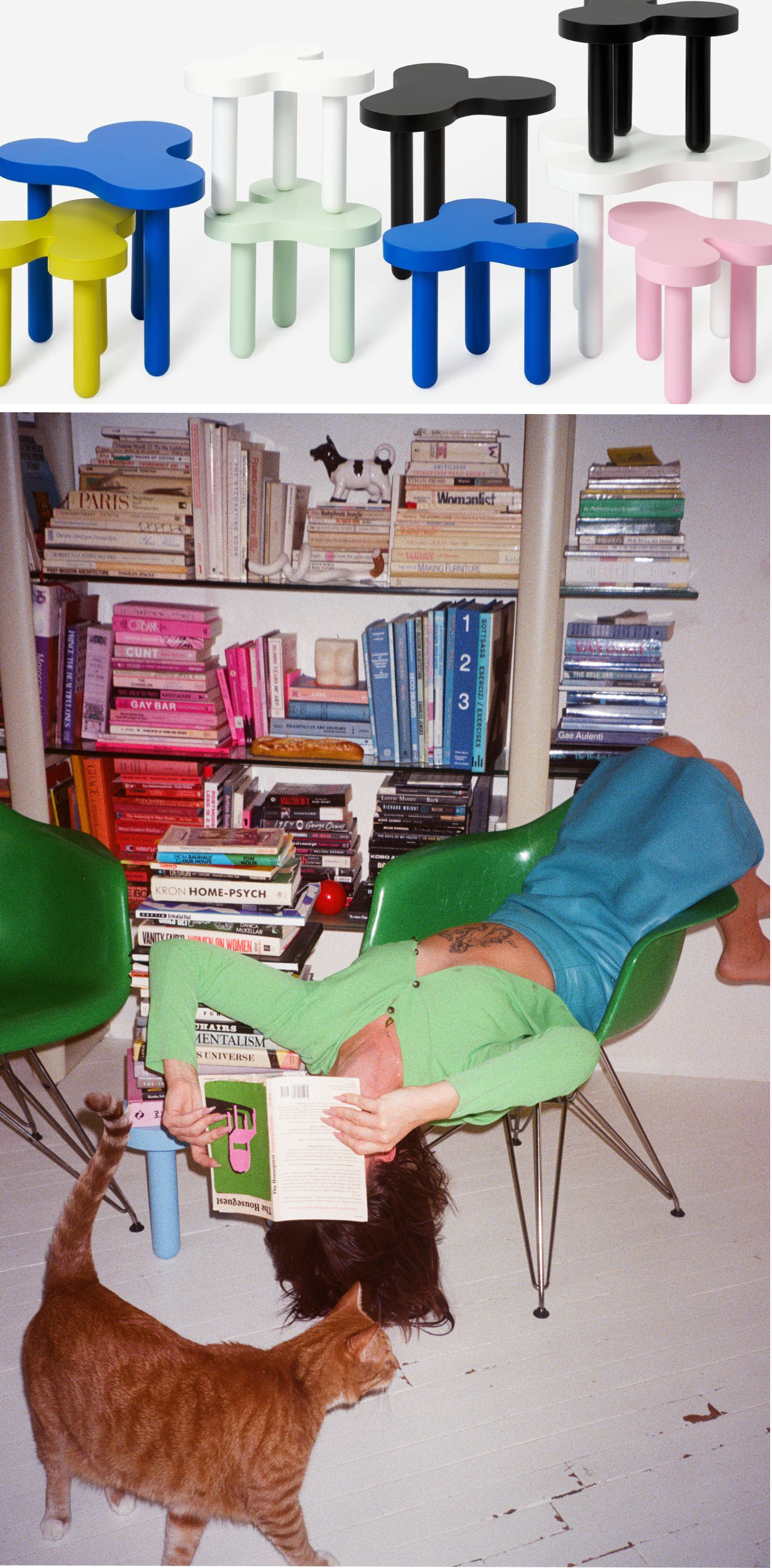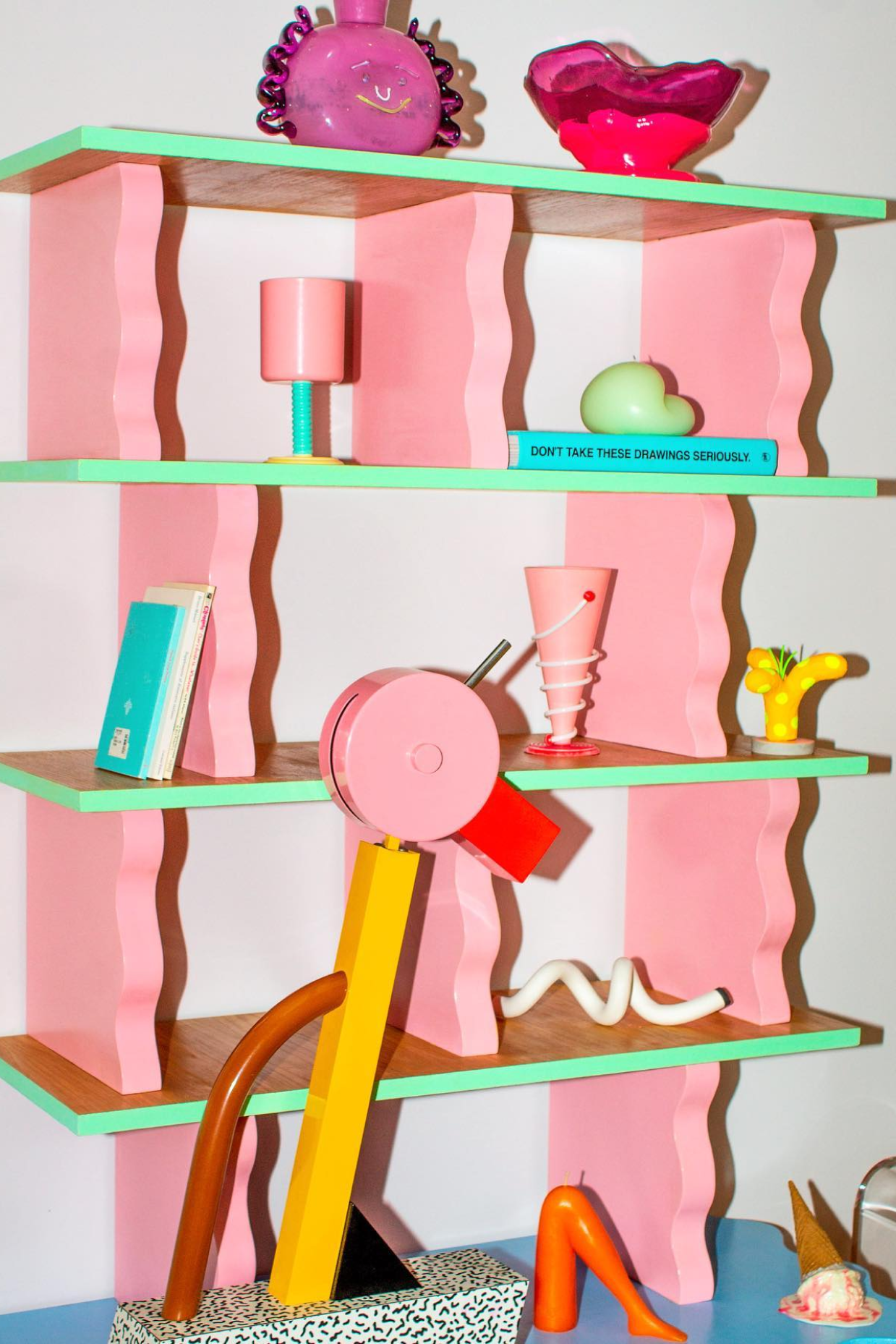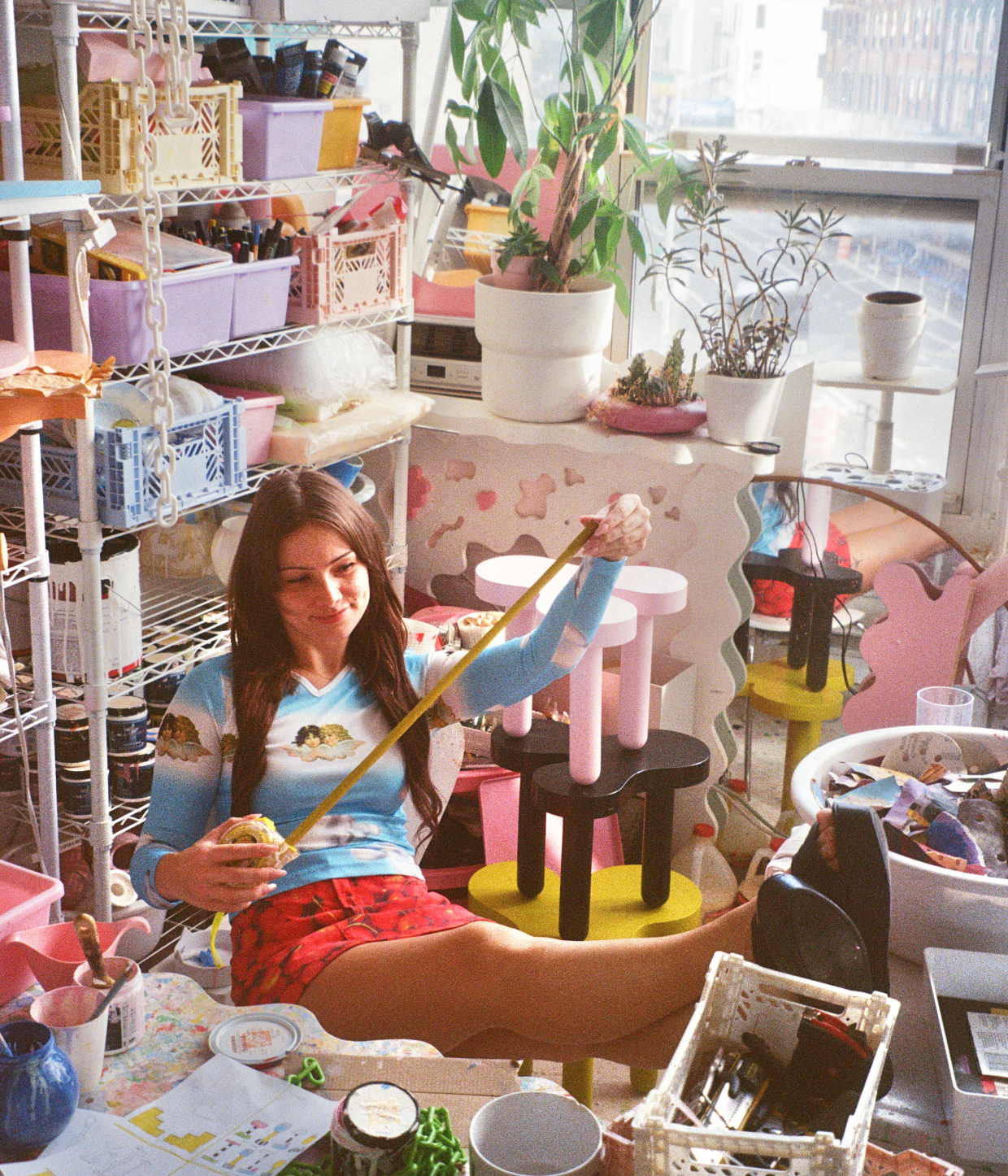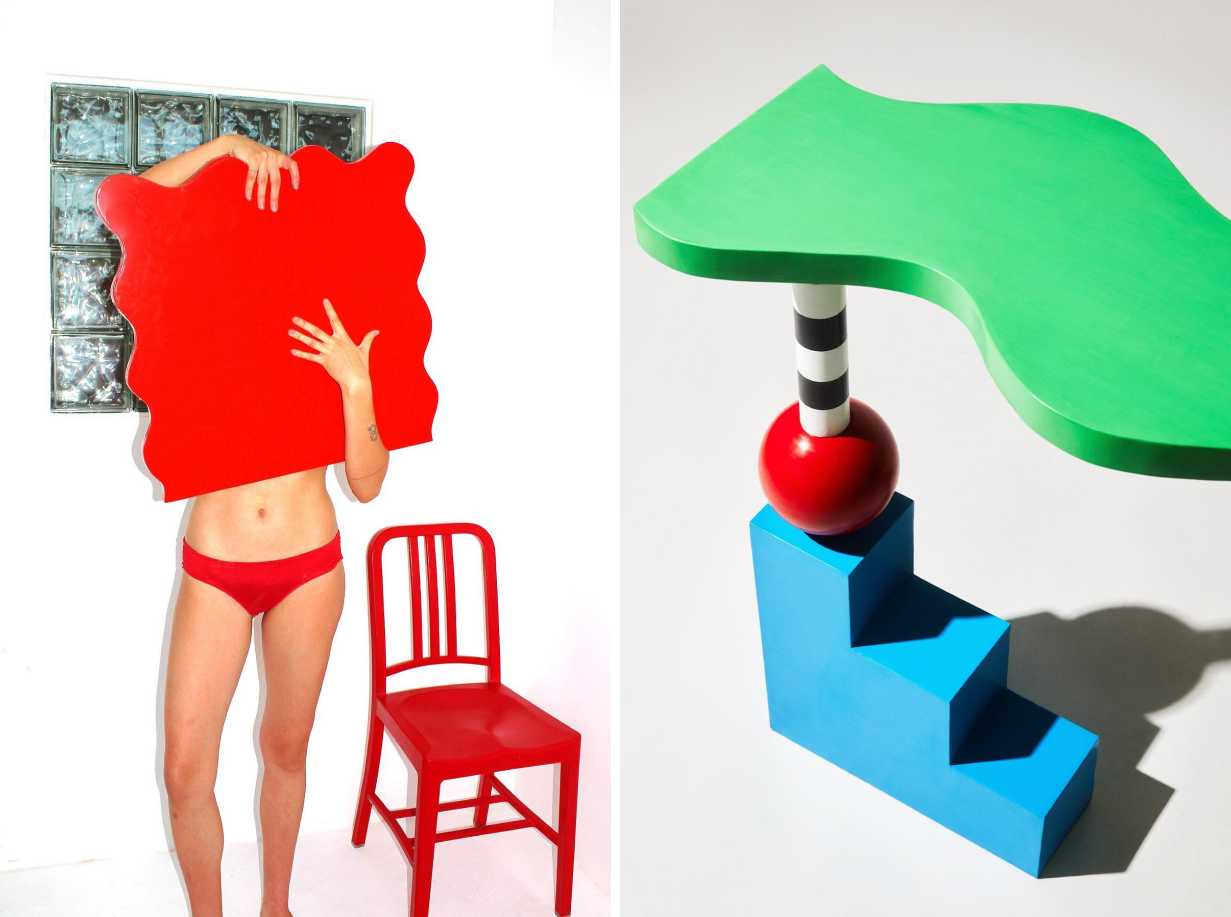After shifting out of the interior design industry mid-pandemic, the celebrated furniture designer and carpentress Sophie Collé has built a radical, bright-pink world of her own, one that revolves around the ethics and ideals from which her practice was born. From her combined studio and living space in New York City, we spoke about her approach and her references that span from Barbie to De Stijl.
Where are you from?
⎯⎯⎯ I'm from Maryland, a very small, very boring state. I grew up around all the big museums though, thanks to my dad working for the government and my mom being an artist. I’m always like, Maryland's so boring, but it's really informed who I am today, so I shouldn't drag Maryland too much.
I think we all like to drag our hometowns a little bit. But it's always fun to look back and realize how much your upbringing has informed what you’re giving to the world. So - tell me all about that.
⎯⎯⎯ Well, I launched my solo studio during covid. Before that, I was working in high-end residential interior design. The clientele were people whose kids went to the same school as Trump's kids. So it was a pretty high stress job, where everything was an emergency when it didn’t need to be. My bosses didn’t seem to care about Covid, or George Floyd - they were mainly annoyed they couldn’t post on Instagram.
I was quarantined with my parents in Maryland, and had room to play with my dad’s tools. I was just so frustrated with the world at large. I’m like, I can’t survive this job anymore, I don’t need the money cause I’m on unemployment, let me try to make furniture in exchange for donations and mutual aid organizations. It worked really well for a few months and I donated a tonne of money. Then I went back to New York and continued the project, and needed to figure out how to turn this into a business that still works in the community, still helps people and is still sustainable.

I didn’t realize that your practice was born from you realigning with your ideals.
⎯⎯⎯ It was completely philanthropy based. It feels a bit odd now cause it can't operate that way anymore. I still do whatever I can at the end of the month: donating, venmoing people, dropping off groceries. My big, ten-year plan is to make enough money so I can return to that. To open some sort of formal fund, or formal school, something that brings back the inception of the project.
At what point did it turn into what it is now?
⎯⎯⎯ It was insane, cause everyone was on Instagram during Covid. I left a Google form open one night and got forty orders overnight. That's when I was like, oh my God, this is going to work. But this is also not going to work. So ever since that moment it's just been about undoing some of my mistakes - like refunding people, breaking promises I didn’t want to break, and so on.
All the things that happen when you get very popular overnight. Are you self-taught?
⎯⎯⎯ I didn’t start making furniture until after I graduated college. But, I went to Virginia Tech for industrial design. It’s a very big engineering/football school. I probably stayed in the closet for another four years because of that school. But, I did meet my two best friends there, who are both here in New York now, including my business partner, Sara. The curriculum there was focused on commerce-driven design, medical design, shoe design, nothing artistic. I should have gone to art school, honestly. But my dad wanted me to get a bachelor of science.
How did you get into furniture if not at school?
⎯⎯⎯ I had this prof in first year, and this is the project that really launched the interest for me: she had us draw a single object every day for thirty days to study all the different perspectives. She encouraged me to use an armchair as my subject, but was like, you're not doing the armchair in your dorm room. She took me to the art and architecture library at my school, which is full of famous vintage designer chairs. I fell in love with this Alvaar Aalto armchair, the Paimio armchair designed for Tuberculosis hospitals - it’s such an art piece. Of course there were Eames armchairs, also a Panton. She spent an hour that day bringing me around telling the history, showing me all the chairs.
So you had this moment of discovery that altered your course.
⎯⎯⎯ Yeah, I'm so grateful for her. I only had three female teachers through school, and she was one of them, She literally changed my life. So that was the start of chairs for me, and since then it's never really faltered. That's why school was so frustrating for me - every time we got a new project, I always wanted to spin it into furniture but they wouldn't let me. It was always about how to design a remote control to cure cancer or something. Super important stuff, but just not what I wanted to pursue.
I think there’s a certain value in having constraints because they stimulate unexpected expressions of creativity. Have any of those boring assignments turned into something exciting for you?
⎯⎯⎯ One project I did ended up being a favorite of mine. It was a lighting project, and I designed a handheld flashlight that looked more like an elegant toy than a light. My one professor told me it was MoMa design store worthy (literally the only compliment I ever got on projects in school) so I’ve held that dearly, especially since my splat tables are in the MoMa store now. That project was one of the few where I found a middle ground of designing a boring thing like a flashlight, and making it chic.

Amazing. And another key element of your work is color - let’s talk about that.
⎯⎯⎯ All my projects in school started out being gray, made of birchwood, and so on. Very industrial design. But for my thesis, I did a project on museums. I’m such a museum head, I'm obsessed. Anyway, I made the whole presentation red. I was like, wait, this is the sexiest color in the world. Then after I graduated, I worked at a museum in Potomac. Every day I was surrounded by Calder, surrounded by Lygia Pape, all these artists whose entire breadth of work is about color. I was discovering radical Italian art, De Stijl, radical furniture, postmodernism - it started with all the white guys.
Yeah, the canonized artists. I had to go study art history at university to learn that there even were female artists back in the day.
⎯⎯⎯ Yeah, exactly! When I discovered Memphis, I was like, oh my God? There are two women in this group? And there are people of color? People inspired by India and Africa, from places that are not normally formally celebrated in Western European art. And they're all actually crediting their sources. In every single one of Sottsass's memoirs there are fifty pages about his explorations in India. Same with Nathalie du Pasquier and her travels in West Africa.
Memphis is a big reference for you.
⎯⎯⎯ For me, Memphis was this perfect encapsulation of a cultural melting pot, ethics, of them crediting their sources, and also it all being so ridiculous. People hated it at first.
Yeah, at the time, people thought Memphis was gonna be this passing thing.
⎯⎯⎯ When Sottsass presented the group’s first collection, he did not think that people were gonna leave the Salone to come see his exhibition. Because it was really just this big, fun rejection of the mainstream. And, not to put myself in that same category, but I have quit or been fired from every job I've ever had. And this is where I've ended up [gestures to her self-renovated studio and living space, complete with wood shop and painting room]. So this is like my little, mini Memphis. It's totally fine that I can't hold down a normal job with an employer because I'm outspoken and talk too much.
I hear this often from female artists. They’re like driving forces who can’t fit in and need to pave their own way, create their own worlds, like you have.
⎯⎯⎯ Yeah, it's the only way to do it. Because you speak up once or twice… Well, this is why I got fired from my museum job. I gave my thirty days and they said no, you can leave today. I saw so many violations there, things that should not be happening at museums run by billionaires, and I was so outspoken about it.
But while I was there, I was so bored all the time, so I was constantly sketching, constantly drawing, constantly reading. It was like a mini grad school in that sense. So everything I'm building now was really sketched out in 2018.

And now you’re making furniture that’s very celebrated - there’s a big Memphis revival happening. The history of design is basically a cyclical pattern of maximalism and minimalism alternately reacting to the other. Where would you say we are now?
⎯⎯⎯ We're in an interesting spot. There are some parallels with the eighties. That Trump aesthetic favored by rich people, that started with Reagan. That kind of excessive spending was heightened by TV advertisements in the eighties, similar to how it is now. These huge companies that are doing collabs with designers in an attempt to boost their own cache, like, “we’re good people working with small designers.”
They’re still functioning off those same principles from the 1980s, like “we’re out of the pandemic, people have money again, the recession is looming and people are depressed because of climate change, so they’re spending their money.” So this post-Covid, post-Trump, Reagan-era renaissance that we’re having is just a painkiller, that's how I see it. Furniture and design only live out of people wanting to spend their disposable income. It's a complete luxury.
I’ve noticed that designers in our generation are embracing a very playful aesthetic. Maybe it’s a post-pandemic thing, like, let’s have fun again.
⎯⎯⎯ Yeah, It's insane. People will say to me that my furniture is the thing that's made them happiest in years, and I'm like, that's not good, mama! I'm happy for me, but…. I do see these parallels with the Reagan era. I hope color doesn't fade away. When I go down my Tik-Tok spirals, I'm like, oh God, it's coming back. Gray is coming back.
She’s coming back [laughs]. And then what about your references outside of design, cinematic references?
⎯⎯⎯ I’m such a big set design girlie. Anything Sofia Coppola, obviously. Jacques Tati. His movies have really informed the humor in my work, especially Playtime - there's no dialogue, and it's three hours long - so you focus on the set design. His movie Mon Oncle has one of the most amazing houses by Gio Ponti. Then my favorite, favorite, favorite movie of all time is called Toys. You can tell Ferdinando Scarfiotti, the designer, was inspired by Magritte and surrealism. All the stills from that movie are insane.
Even when I was six it was the most beautiful thing I’d ever seen. The plot is that this old man dies and his kids have to take over the toy company - one’s in the military and wants to make military toys, the other one, he just wants to make toys for the sake of joy. That dynamic is literally the design world, which I didn't realize when I was six but when I rewatched it at twenty.
I saw Barbie recently. It was when I was researching this interview, and I was like, why didn't they call her for the set?
⎯⎯⎯ I know, it's so funny. I did my entire house pink in 2021. I did this whole pink experiment, definitely a return to my childhood. I was like, I'm no longer in design school, I'm not embarrassed to be using the color pink, let's go crazy. It was more of a collecting journey: how many pink things can I find on Facebook Marketplace? A lot. By the time the Barbie movie rolls around, I'm tired of it. I'm like, I don't want this pink house anymore, I don’t want any more interviews about Barbiecore!

I looked at the feedback on your house that you posted on Instagram. Pink is obviously a very powerful color - people really respond to it.
⎯⎯⎯ Yeah! Like Allen!
What I love about your work is that you’re queering this traditionally masculine, male-dominated practice. How is that generally received?
⎯⎯⎯ Generally super positive. It’s what most of everything I do is. My dream is to have a school for girls and gays and theys, so they can have a place to learn carpentry in peace. Every time I was in the workshop it was like - what are you wearing, why is your hair like that? I understand the safety precautions, but you don't have to be commenting on my ponytail or going “Hi, sweetie” when I walk in the door.
That's why I did not do a furniture thesis in my last year of design school, because I wanted peace. And the amount of experience I missed out on just to protect my peace is why I get so angry and riled up. It's still happening, like on every trip to Home Depot. They force me to let them help me and they know less than I do. So it's just - it's what you make it. If I just lived on the internet and only listened to the positivity, it would be really, really great.
Yeah, and your aesthetic is very much the inverse of Home Depot’s, which is symbolic given the ethos you just described.
⎯⎯⎯ I don't like giving them any of my money. When I have the time, I'll drive the extra forty minutes to the Lowe’s, but it's not always manageable. Though I have gotten pretty good about ordering online from smaller companies.
We need to make extra time for all these detours to maintain our peace.
⎯⎯⎯ So things move at a slower pace. Sara and I have not even been able to find a manufacturer run by a female-led team. The last manufacturer we spoke to, the emails he sent us were insane. If it weren't my real life it would be funny. He’d be like “you either place 100k worth of orders with us or you will have to watch your business fail, dot dot dot.” Did chat GPT write this for you? Humans don’t write this way. My business isn't failing, I'm just moving at my own pace.
Because you’re living and working according to your ideals.
⎯⎯⎯ Yeah. And the thing is that no matter what, you still have to pay your rent, so decisions become even harder. Because there will be no business if I get kicked out of my studio - so you gotta make the tough calls once in a while. My biggest nightmare is having the Jeff Koons effect where you have two hundred people in your studio producing everything and creating new ideas for you. They're receiving none of the credit, none of the estate money, none of the licensing money.

So what does the future hold for you?
⎯⎯⎯ I'm trying to find more brands like Areaware that are willing to support my vision, as well as individual patrons who support my vision. The guy who commissioned the Memphis console table on my Instagram, he's a huge Memphis head. I’m trying to find more people like that who can help me get to the next level without - as you said - compromising my ideals. And then this year, I really wanna learn new technical skills. I wanna make a crazy desk that has more hinges and more drawers, something that requires more technical skills that I haven't had time to explore. I want to do large-scale, I wanna make a huge bookshelf, also a huge, sexy media étagère. I want to physically grow with bigger pieces. I also have a new line for pets that I’ll be releasing soon.
Finally, did you get the intel on the weird, wild Barbie stories from the 60’s?
⎯⎯⎯ I have not received an email back. You're not the only person who's asked. Lots of people are checking in on this. I’ll have to double email her. I sent her my phone number and everything. When I get feedback like that, it makes it all worth it - there are good days and bad days.
It's what happens when you put the full expression of yourself out there.
⎯⎯⎯ And the thing is, at the end of it all, they are still on top and somehow they’re still upset. It's moments like that where I'm like, Allen, your wife just emailed me cause you’re not listening to her stories [laughs]
– East Room is a shared workspace company providing design-forward office solutions, authentic programming and a diverse community to established companies and enterprising freelancers. We explore art, design, music, and entrepreneurship. Visit our news & stories page to read more.